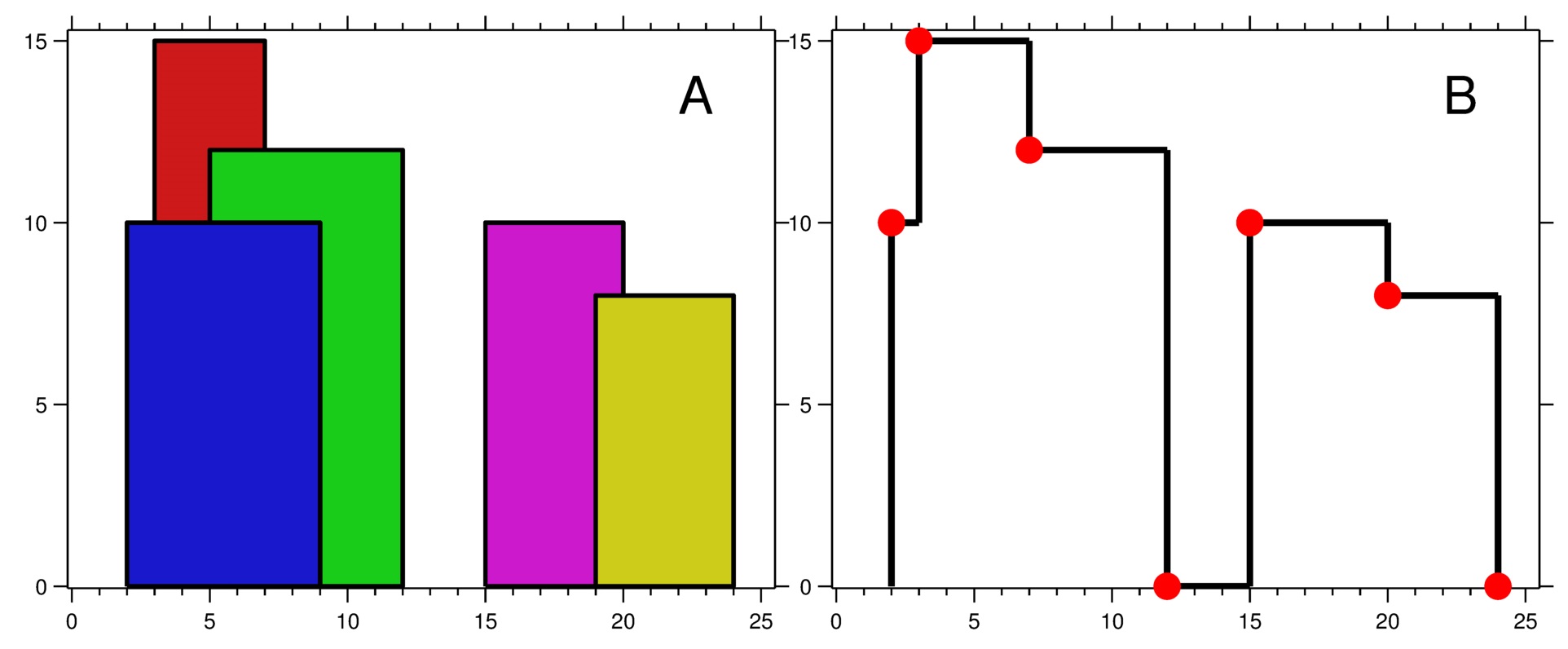The Skyline Problem
Problem Statement
A city's skyline is the outer contour of the silhouette formed by all the buildings in that city when viewed from a distance. Given the locations and heights of all the buildings, return the skyline formed by these buildings collectively.
The geometric information of each building is given in the array buildings where buildings[i] = [lefti, righti, heighti]:
leftiis the x coordinate of the left edge of the ith building.rightiis the x coordinate of the right edge of the ith building.heightiis the height of the ith building.
You may assume all buildings are perfect rectangles grounded on an absolutely flat surface at height 0.
The skyline should be represented as a list of "key points" sorted by their x-coordinate in the form [[x1,y1],[x2,y2],...]. Each key point is the left endpoint of some horizontal segment in the skyline except the last point in the list, which always has a y-coordinate 0 and is used to mark the skyline's termination where the rightmost building ends. Any ground between the leftmost and rightmost buildings should be part of the skyline's contour.
Note: There must be no consecutive horizontal lines of equal height in the output skyline. For instance,[...,[2 3],[4 5],[7 5],[11 5],[12 7],...]is not acceptable; the three lines of height 5 should be merged into one in the final output as such: [...,[2 3],[4 5],[12 7],...]
Example 1:
Input: buildings = [[0,2,3],[2,5,3]]
Output: [[0,3],[5,0]]
Example 2:

Input: buildings = [[2,9,10],[3,7,15],[5,12,12],[15,20,10],[19,24,8]]
Output: [[2,10],[3,15],[7,12],[12,0],[15,10],[20,8],[24,0]]
Explanation:
- Figure A shows the buildings of the input.
- Figure B shows the skyline formed by those buildings. The red points in
figure Brepresent the key points in the output list.
Constraints:
1 <= buildings.length <= 1040 <= lefti < righti <= 231 - 11 <= heighti <= 231 - 1- buildings is sorted by left
iin non-decreasing order.
Code
class Solution {
public List<int[]> getSkyline(int[][] buildings) {
List<int[]> res = new ArrayList<>();
List<int[]> height = new ArrayList<>(); // height list to store all buildings' heights
for (int[] b : buildings) {
height.add(new int[]{b[0], - b[2]}); // start of a building, height stored as negtive
height.add(new int[]{b[1], b[2]}); // end of a building, height stored as positive
}
Collections.sort(height, (a, b) -> (a[0] == b[0] ? a[1] - b[1] : a[0] - b[0])); // sort the height list
// a pq that stores all the encountered buildings' heights in descending order
PriorityQueue<Integer> pq = new PriorityQueue<>((a, b) -> (b - a));
pq.offer(0);
int preMax = 0;
for (int[] h : height) {
if (h[1] < 0) { // h[1] < 0, that means it meets a new building, so add it to pq
pq.offer(-h[1]);
} else { // h[1] >=0, that means it has reached the end of the building, so remove it from pq
pq.remove(h[1]);
}
// the current max height in all encountered buildings
int curMax = pq.peek();
// if the max height is different from the previous one, that means a critical point is met, add to result list
if (curMax != preMax) {
res.add(new int[]{h[0], curMax});
preMax = curMax;
}
}
return res;
}
}